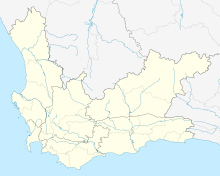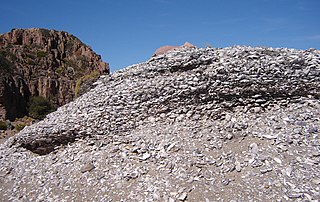
A midden is an old dump for domestic waste which may consist of animal bone, human excrement, botanical material, mollusc shells, potsherds, lithics, and other artifacts and ecofacts associated with past human occupation.

Sand on the Applecross Peninsula in Wester Ross, Scotland, is an archaeological site.
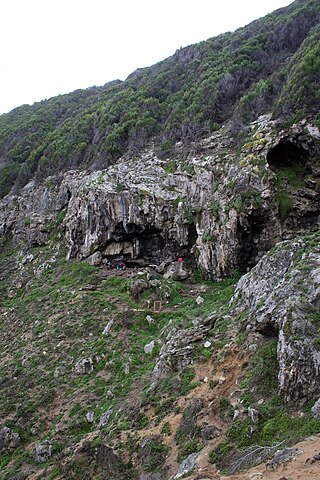
Blombos Cave is an archaeological site located in Blombos Private Nature Reserve, about 300 km east of Cape Town on the Southern Cape coastline, South Africa. The cave contains Middle Stone Age (MSA) deposits currently dated at between c. 100,000 and 70,000 years Before Present (BP), and a Late Stone Age sequence dated at between 2000 and 300 years BP. The cave site was first excavated in 1991 and field work has been conducted there on a regular basis since 1997, and is ongoing.
Chibuene is a Mozambican archaeological site, located five kilometres south of the coastal city of Vilanculos South Beach. The site was occupied during two distinct phases. The earlier phase of occupation dates to the late first millennium AD. The second phase dates from around 1450 and is contemporaneous with the Great Zimbabwe civilization in the African interior. During both phases of its development Chibuene was a trading settlement. Trade goods obtained from the site include glass beads, painted blue and white ceramics, and glass bottle fragments. The later phase of settlement has yielded remains of medieval structures as well as evidence of metallurgy. Crucibles have been found that were presumably used to melt gold obtained from trade with the Great Zimbabwe civilization. There is evidence that Chibuene traded extensively with the inland settlement of Manyikeni. Mozambique has jointly inscribed these two properties on their tentative version of the World Heritage List.
Mumba Cave, located near the highly alkaline Lake Eyasi in Karatu District, Arusha Region, Tanzania. The cave is a rich archaeological site noted for deposits spanning the transition between the Middle Stone Age and Late Stone Age in Eastern Africa. The transitional nature of the site has been attributed to the large presence of its large assemblage of ostrich eggshell beads and more importantly, the abundance of microlith technology. Because these type artifacts were found within the site it has led archaeologists to believe that the site could provide insight into the origins of modern human behavior. The cave was originally tested by Ludwig Kohl-Larsen and his wife Margit in their 1934 to 1936 expedition. They found abundant artifacts, rock art, and burials. However, only brief descriptions of these findings were ever published. That being said, work of the Kohl-Larsens has been seen as very accomplished due to their attention to detail, especially when one considers that neither was versed in proper archaeological techniques at the time of excavation. The site has since been reexamined in an effort to reanalyze and complement the work that has already been done, but the ramifications of improper excavations of the past are still being felt today, specifically in the unreliable collection of C-14 data and confusing stratigraphy.
Enkapune Ya Muto, also known as Twilight Cave, is a site spanning the late Middle Stone Age to the Late Stone Age on the Mau Escarpment of Kenya. This time span has allowed for further study of the transition from the Middle Stone Age to the Late Stone Age. Beads made of perforated ostrich egg shells found at the site have been dated to 40,000 years ago. The beads found at the site represent the early human use of personal ornaments.
Pinnacle Point a small promontory immediately south of Mossel Bay, a town on the southern coast of South Africa. Excavations since the year 2000 of a series of caves at Pinnacle Point have revealed occupation by Middle Stone Age people between 170,000 and 40,000 years ago. The focus of excavations has been at Cave 13B (PP13B), where the earliest evidence for the systematic exploitation of marine resources (shellfish) and symbolic behaviour has been documented, and at Pinnacle Point Cave 5–6 (PP5–6), where the oldest evidence for the heat treatment of rock to make stone tools has been documented. The only human remains have been recovered from younger deposits at PP13B which are c. 100,000 years old.
Wildebeest Kuil Rock Art Centre is a rock engraving site with visitor centre on land owned by the !Xun and Khwe San situated about 16 km from Kimberley, Northern Cape, South Africa. It is a declared Provincial Heritage Site managed by the Northern Cape Rock Art Trust in association with the McGregor Museum. The engravings exemplify one of the forms often referred to as ‘Bushman rock art' – or Khoe-San rock art – with the rock paintings of the Drakensberg, Cederberg and other regions of South Africa being generally better known occurrences. Differing in technique, the engravings have many features in common with rock paintings. A greater emphasis on large mammals such as elephant, rhino and hippo, in addition to eland, and an often reduced concern with depicting the human form set the engravings apart from the paintings of the sub-continent.

Diepkloof Rock Shelter is a rock shelter in Western Cape, South Africa in which has been found some of the earliest evidence of the human use of symbols, in the form of patterns engraved upon ostrich eggshell water containers. These date around 60,000 years ago.
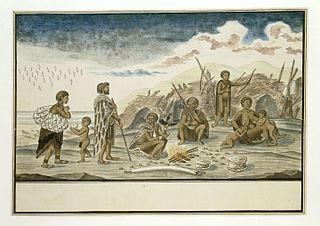
The Strandlopers are a Khoikhoi-derived people who live by hunting and gathering food along the beaches of south-western Africa, originally from the Cape Colony to the Skeleton Coast.

Heritage Western Cape (HWC) is a provincial heritage resources authority established by the Minister of Cultural Affairs and Sport of the government of the Western Cape province in South Africa. It is a public entity set up under the terms of the National Heritage Resources Act. It is mandated to care for that part of South Africa's national estate that is of provincial and local significance in the Western Cape. It may delegate responsibility for heritage resources of local significance to competent municipal governments.

Nelson Bay Cave also known as Wagenaar's Cave is a Stone Age archaeological site located on the Robberg Peninsula and facing Nelson's Bay near Plettenberg Bay in South Africa, and showing evidence of human occupation as far back as 125,000 years ago.
Karim Sadr is an archaeologist contributing to research in southern Africa. He is the author of over 60 academic articles, a book and two edited volumes. While Sadr has contributed to the Kalahari Debate, his more recent work has focused on historical revision, re-examining the acquisition of domesticated animals and pottery in southern Africa by Hunter-gatherer. His work is reintroducing the term Neolithic back into southern African archaeological discourse from which it had previously been removed.
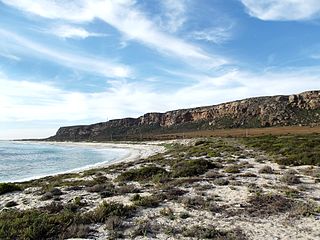
Mussel Point also known as Mike Taylor's Midden (MTM) is possibly the largest of 13 megamiddens found along the South African West Coast. MTM is the only open site with remains from the early pottery period in the Elands Bay and Lamberts Bay areas at 32°18′S18°19′E.

Verlorenvlei Heritage Settlement is situated in the Piketberg District, South Africa. 32°19′ S 18° 23′ E. The settlement consists of surviving Langhius structures in what was once a thriving Hamlet on the shores of the Verlorenvlei. A remnant of this sort is unique and is the reason behind the site being declared a provincial heritage site.
Elands Bay Cave is located near the mouth of the Verlorenvlei estuary on the Atlantic coast of South Africa's Western Cape Province. The climate has continuously become drier since the habitation of hunter-gatherers in the Later Pleistocene. The archaeological remains recovered from previous excavations at Elands Bay Cave have been studied to help answer questions regarding the relationship of people and their landscape, the role of climate change that could have determined or influenced subsistence changes, and the impact of pastoralism and agriculture on hunter-gatherer communities.
Melkhoutboom Cave is an archaeological site dating to the Later Stone Age, located in the Zuurberg Mountains, Cape Folded Mountain Belt, Sarah Baartman District Municipality in the Eastern Cape Province of South Africa.

The Mlambalasi Rock Shelter is a historic site located in Iringa District of Iringa Region in southern Tanzania, 50 km away from Iringa City. Excavations in 2006 and 2010 by the Iringa Region Archaeological Project uncovered artifactual deposits from the Later Stone Age (LSA), the Iron Age, and the historic periods, as well as external artifacts from the Middle Stone Age (MSA). Direct dating on Achatina shell and ostrich eggshell beads indicates that the oldest human burials at Mlambalasi are from the terminal Pleistocene. Mlambalasi is characterized by interment LSA and Iron Age periods, as well as by cycles of use and abandonment.
Ostrich eggshell beads, considered among the earliest ornaments created by Homo sapiens, represent some of the most ancient fully manufactured beads. Archaeologists have traced their origins back to the Late Pleistocene, with evidence suggesting they were crafted as early as 75,000 years ago in Africa. Certain populations continue to produce and utilize these beads in contemporary times.
